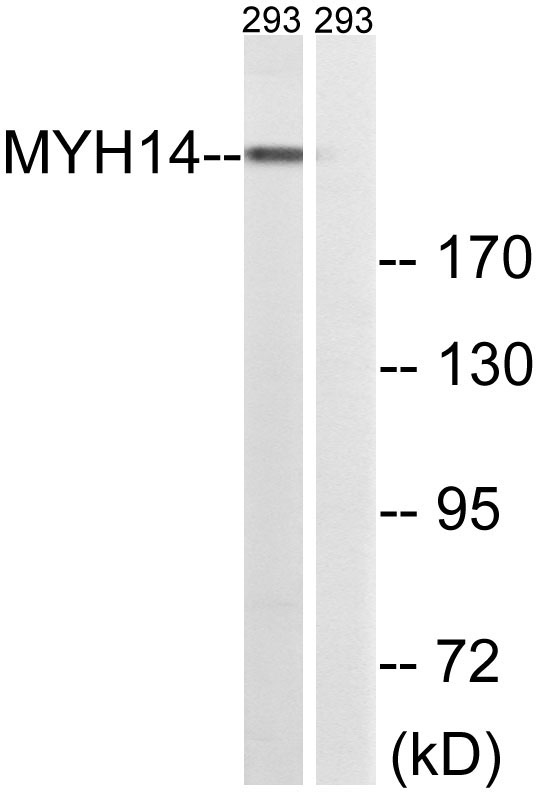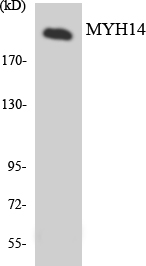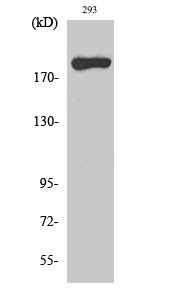产品名称
MYH14 Rabbit Polyclonal Antibody
别名
MYH14; KIAA2034; FP17425; Myosin-14; Myosin heavy chain 14; Myosin heavy chain; non-muscle IIc; Non-muscle myosin heavy chain IIc; NMHC II-C
存储缓冲液
Liquid in PBS containing 50% glycerol, 0.5% BSA and 0.02% New type preservative N.
Human Gene Link
http://www.ncbi.nlm.nih.gov/sites/entrez?db=gene&term=79784
Human Swissprot No.
Q7Z406
Human Swissprot Link
http://www.uniprot.org/uniprotkb/Q7Z406/entry
Mouse Gene Link
http://www.ncbi.nlm.nih.gov/sites/entrez?db=gene&term=71960
Mouse Swissprot No.
Q6URW6
Mouse Swissprot Link
http://www.uniprot.org/uniprot/Q6URW6
免疫原
The antiserum was produced against synthesized peptide derived from human MYH14. AA range:1051-1100
特异性
MYH14 Polyclonal Antibody detects endogenous levels of MYH14 protein.
稀释度
WB 1:500 - 1:2000. IHC 1:100 - 1:300. ELISA: 1:5000.. IF 1:50-200
宿主
Polyclonal, Rabbit,IgG
背景介绍
This gene encodes a member of the myosin superfamily. The protein represents a conventional non-muscle myosin; it should not be confused with the unconventional myosin-14 (MYO14). Myosins are actin-dependent motor proteins with diverse functions including regulation of cytokinesis, cell motility, and cell polarity. Mutations in this gene result in one form of autosomal dominant hearing impairment. Multiple transcript variants encoding different isoforms have been found for this gene. [provided by RefSeq, Dec 2011],
组织表达
High levels of expression are found in brain (highest in corpus callosum), heart, kidney, liver, lung, small intestine, colon and skeletal muscle. Expression is low in organs composed mainly of smooth muscle, such as aorta, uterus and urinary bladder. No detectable expression is found in thymus, spleen, placenta and lymphocytes.
细胞定位
stress fiber,cytosol,brush border,membrane,myosin complex,myosin II complex,axon,growth cone,actomyosin,myelin sheath,extracellular exosome,myosin II filament,
信号通路
Tight junction;Regulates Actin and Cytoskeleton;Viral myocarditis;
功能
disease:Defects in MYH14 are the cause of non-syndromic sensorineural deafness autosomal dominant type 4 (DFNA4) [MIM:600652]. DFNA4 is a form of sensorineural hearing loss. Sensorineural deafness results from damage to the neural receptors of the inner ear, the nerve pathways to the brain, or the area of the brain that receives sound information.,domain:The rodlike tail sequence is highly repetitive, showing cycles of a 28-residue repeat pattern composed of 4 heptapeptides, characteristic for alpha-helical coiled coils.,function:Cellular myosin that appears to play a role in cytokinesis, cell shape, and specialized functions such as secretion and capping.,sequence caution:Translation N-terminally extended.,similarity:Contains 1 IQ domain.,similarity:Contains 1 myosin head-like domain.,subunit:Myosin is a hexameric protein that consists of 2 heavy chain subunits (MHC), 2 alkali light chain subunits (MLC) and 2 regulatory light chain subunits (MLC-2).,tissue specificity:High levels of expression are found in small intestine, colon and skeletal muscle. Expression is low in organs composed mainly of smooth muscle, such as aorta, uterus and urinary bladder. No detectable expression is found in thymus, spleen, placenta and lymphocytes.,
纯化
The antibody was affinity-purified from rabbit antiserum by affinity-chromatography using epitope-specific immunogen.



